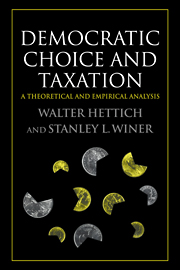Book contents
- Frontmatter
- Contents
- Preface
- 1 Introduction
- PART ONE THEORETICAL FRAMEWORK
- 2 Models of Political Economy and the Study of Taxation
- 3 Foundations of Democratic Tax Systems
- 4 Tax Structure in Equilibrium: A More Formal Model
- PART TWO COLLECTIVE CHOICE AND THE NORMATIVE ANALYSIS OF TAXATION
- PART THREE APPLIED GENERAL EQUILIBRIUM ANALYSIS
- PART FOUR STATISTICAL ANALYSIS OF TAX STRUCTURE
- PART FIVE POLITICAL INSTITUTIONS AND TAXATION
- Bibliography
- Name Index
- Subject Index
2 - Models of Political Economy and the Study of Taxation
Published online by Cambridge University Press: 08 October 2009
- Frontmatter
- Contents
- Preface
- 1 Introduction
- PART ONE THEORETICAL FRAMEWORK
- 2 Models of Political Economy and the Study of Taxation
- 3 Foundations of Democratic Tax Systems
- 4 Tax Structure in Equilibrium: A More Formal Model
- PART TWO COLLECTIVE CHOICE AND THE NORMATIVE ANALYSIS OF TAXATION
- PART THREE APPLIED GENERAL EQUILIBRIUM ANALYSIS
- PART FOUR STATISTICAL ANALYSIS OF TAX STRUCTURE
- PART FIVE POLITICAL INSTITUTIONS AND TAXATION
- Bibliography
- Name Index
- Subject Index
Summary
It is possible to go further and to consider the public sector in another way. One then tries to explain the actions of public authorities as determined by, for instance, such things as the various influences of social classes and pressures, the social mechanism of selection of leaders of state and municipal institutions, their knowledge or lack of knowledge when taking decisions, etc. This will be a theory about politics.
Leif Johansen (1965, p. 6)The suitability of a model depends as much on what is left out as on what is put in.
Martin Shubik (1984, p. 11)We begin the study of the power to tax in democratic states with a review of six well-known models that have been used to investigate important aspects of the formation or evolution of tax systems. Five of them include collective choice as an integral part. Johansen's challenge to “go further and to consider the public sector in another way” has not gone unanswered in the fiscal literature during the last four decades. Many authors have attempted to explain how selected aspects of tax systems, or tax structure as a whole, emerge in an equilibrium resulting from the interaction of the private economy and the political process. The major contending frameworks include the median voter model, structure-induced equilibrium, probabilistic voting, the Leviathan model, and cooperative game theory. We provide a sketch of each of these approaches.
- Type
- Chapter
- Information
- Democratic Choice and TaxationA Theoretical and Empirical Analysis, pp. 11 - 41Publisher: Cambridge University PressPrint publication year: 1999



